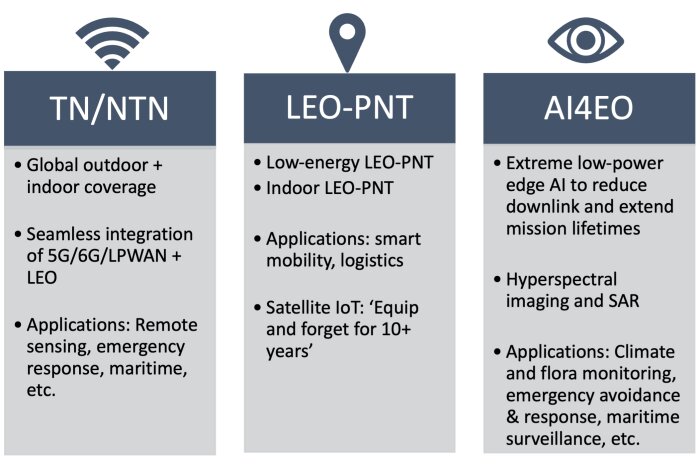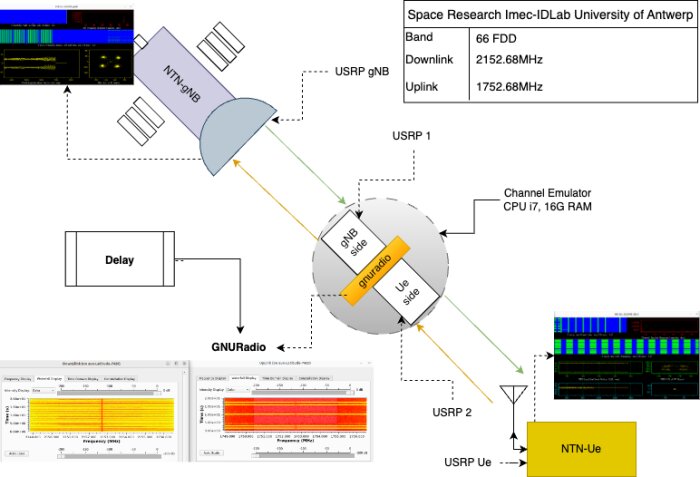At imec-IDLab, the space research track (led by Dr. Thomas Janssen) focuses on 3 pillars:
- Communication: Hybrid communication between Terrestrial and Non-Terrestrial Networks. This involves the seamless integration of LPWAN, 5G, 6G and beyond with LEO satellites. Therefore, we leverage our expertise in terrestrial wireless connectivity and Artificial Intelligence.
- Localization: Positioning, Navigation and Timing with Low Earth Orbit satellites (LEO-PNT). We focus on low-energy, indoor and outdoor satellite positioning using novel LEO-PNT technologies and techniques. We collaborate with both Flemish and international partners in multiple LEO-PNT projects coordinated by Flanders Space/VRI and ESA, respectively.
- Earth Observation: Applying Artificial Intelligence on the edge (Edge-AI) onboard Earth Observation (EO) satellites. This includes software-based fault tolerance for extreme edge systems, as well as onboard adaptive systems for extended mission lifetimes of micro-, cube-, and small-sats.
-
 3 pillars of space research
3 pillars of space research
A selection of projects
- ESA-project: “Breadboarding of innovative user technologies for very low energy positioning” (BreadBoardPos)
Consortium: OHB Digital Solutions (Austria), Peopletrust (Italy), imec-IDlab
Traditional GNSS receivers generally consume too much energy for IoT applications. The objective of this project was to compute a location estimate of an IoT device with as little energy as possible. Therefore, terrestrial LPWAN technologies are combined with novel GNSS techniques (e.g., Snapshot GNSS) and LEO-PNT (e.g., Doppler positioning). After the design and implementation of a breadboard integrating these technologies, it was shown that interoperability is key to providing a location estimate at any time and at any place on Earth.
-
 BreadBoardPos
BreadBoardPos
- ESA-project: “Low Earth Orbit Navigation Analysis, Reporting and Design” (LEONARD)
Consortium: imec-IDlab
As a follow-up on the BreadBoardPos project, ESA requested IMEC to survey, analyze, and simulate state-of-the-art LEO-PNT technologies and techniques. Extensive MATLAB simulations included link budget analyses, receiver design trade-offs, and different use case scenarios for LEO-PNT. Moreover, techniques such as pseudoranging and Doppler PNT were compared in terms of PNT performance.
-
 LEONARD
LEONARD
- Flanders Space / VRI ICON: “Mastering Onboard Vision Intelligence and Quality” (MOVIQ)
Consortium: MAGICS, OIP Space Instruments, VITO, imec, Redwire Space Europe
Press release: First Space ICON project 'MOVIQ' has officially started! - Flanders Space
MOVIQ proposes an artificial intelligence (AI)-accelerated flexible and adaptable remote-sensing imaging solution. The platform will feature multi-instrumentation support and onboard AI for application autonomy. A hyperspectral imaging application will showcase the performance, adaptability, bandwidth, latency, and resource consumption advantages of MOVIQ.
-
 MOVIQ
MOVIQ
- ESA-project: 5G NR-based SCPC SDR modem accelerated by Tensor Defined Radio and Open RAN (TAURUS)
Consortium: Cactus (NXGSAT), imec-IDLab
ESA website: TAURUS
The primary objective of this project was to develop a 5G NR Software-Defined Radio (SDR) modem designed to support Geostationary Orbit (GEO), Medium Earth Orbit (MEO), and Low Earth Orbit (LEO) satellite communications. The project was divided into two phases, with IDLab UA actively contributing to both. Phase 1 focused on research, systematic evaluation, and the application of specialized expertise to guide decision-making and facilitate project advancement. This phase explored suitable waveforms for both uplink and downlink and adaptive coding schemes like LDPC and polar codes, tailored for specific channel conditions in Non-Terrestrial Network (NTN) architecture. Additionally, realistic system models were investigated to handle synchronization in both the time and frequency domains, enabling the evaluation of recent NTN enhancements in practical scenarios. Delay-tolerant retransmission mechanisms were also examined for their applicability in real-world NTN implementations. Phase 2 included the development and integration of the software defined modem into a real testbed, marking a significant step toward advancing the accessibility and adoption of NTN technology. This work contributed to enhancing the performance and reliability of satellite-based 5G communications.
Further details can be found at the Cactus webpage.
-
 TAURUS
TAURUS
A selection of publications
- Thomas Janssen, Axel Koppert, Rafael Berkvens and Maarten Weyn, "A Survey on IoT Positioning leveraging LPWAN, GNSS and LEO-PNT," in IEEE Internet of Things Journal, IEEE, 2023, DOI: 10.1109/JIOT.2023.3243207.
- Wout Van Uytsel, Thomas Janssen, Rreze Halili, and Maarten Weyn, "Exploring Positioning through Pseudoranges using Low Earth Orbit Satellites", in Proceedings of the 17th International Conference on P2P, Parallel, Grid, Cloud and Internet Computing (3PGCIC-2022). Springer International Publishing, 2022, DOI: 10.1007/978-3-031-19945-5_28.
- Michiel Aernouts, Thomas Janssen, Rafael Berkvens and Maarten Weyn, "LoRa Localization: With GNSS or Without?," in IEEE Internet of Things Magazine, vol. 5, no. 3, pp. 152-157, September 2022, DOI: 10.1109/IOTM.001.2200019.
- Anuj Justus Rajappa, Philippe Reiter, Tarso Kraemer Sarzi Sartori, Luiz Henrique Laurini, Hassen Fourati, Siegfried Mercelis, Jeroen Famaey, Rodrigo Possamai Bastos, "SMART: Selective MAC zero-optimization for neural network reliability under radiation,” in Microelectronics Reliability, Volume 150, 2023, 115092, ISSN 0026-2714, DOI: 10.1016/j.microrel.2023.115092.


